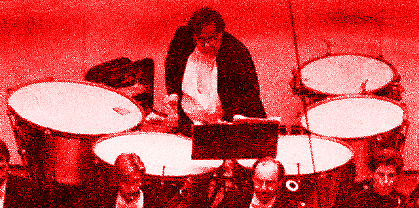Timpani FAQ - Professional Pages

These pages are designed for professional timpanists and percussionists.


(DAT) What is your system for editing and revising timpani parts?
This is a very complex and highly debatable issue that will be dealt with systematically in these pages. Part 1 of this discussion will deal with editing of possible errors in a timpani part, Part 2 will deal with revisions of existing parts due to the limitations of 19th century instruments.
Part 1
Identification of possible errors in timpani parts
We begin with an example, you see the score in question in the graphic to the right. It is from Puccini's Turandot, an opera with an excellent timpani part in addition to lots of interesting percussion. The measure in question is 5 bars before rehearsal #17 in Act One.
The timpani part is circled in red, and the score is complete except for the string parts, which have the same pitches, which are a unison A, then F, then B for the entire orchestra. Looking at the graphic, the third stave down with notes in it is English Horn (in F), staves 4 & 5 are Bb clarinets, staves 8 & 9 are Horns in F, stave 10 is trumpet in F, and the bottom two staves below the percussion parts are offstage trumpets in C and trombones.
Analysis of the score shows that the entire orchestra is playing a unison F on the second beat of the bar, except for the timpani which has an E. The first time I played this passage my ears screamed at me that something was wrong, and I marked it and checked the score later. So, rule #1:
Your ears are the final judge...
which leads directly to rule #2:
Never assume the part is correct...
So, after checking the score, I changed the part so that I am playing the same thing as the rest of the orchestra on the second beat of the bar, an F (a high F). Ironically, the last pitch used previously in that range (i.e., probably played on the same instrument) prior to this measure is an F, a fact which reinforces my opinion that this is a simple misprint. It would also, of course, be possible to play a low F, which requires an additional pedal change but would not be particularly difficult. This would follow the orchestra more accurately, but I have found that I prefer the high F.
Before making such a change, it is important to do some additional homework. You need to be familiar with the composer's style of writing for timpani. I have played nearly all of Puccini's operas many times, and own and have studied the scores to many of them, including Turandot. His orchestration is always extremely careful and accurate, and such a slip of the pen is most unusual.
On the next page we'll deal with a more famous example:
-- Part Two - Part Revision Techniques --

Direct your comments or suggestions for more questions or additional material or additional examples to:
email to Dwight Thomas at:
datimp@cox.net

>> Back to the Dwight Thomas Home Page <<
>> Back to the Timpani FAQ Home Page <<



